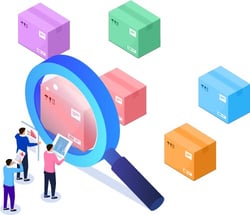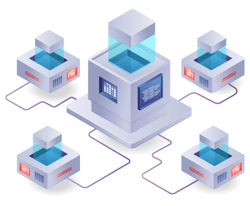 Every company that has developed a product their customer loves wants to repeat the same success. It feels good to know your market and deliver value. Some product teams think about long-term success and put plans in place from the initial design. They know that if their product is successful, they’ll want to create other versions. Even companies who haven’t planned in advance to replicate their products still have a choice to make between these two methods.
Every company that has developed a product their customer loves wants to repeat the same success. It feels good to know your market and deliver value. Some product teams think about long-term success and put plans in place from the initial design. They know that if their product is successful, they’ll want to create other versions. Even companies who haven’t planned in advance to replicate their products still have a choice to make between these two methods.
Sometimes the answer is decided by the nature of the product. Platforms may not be for every product —think of food production or pharmaceutical. Other times, product teams, including engineering and design, can decide which route to take when planning a product family.
How do product teams decide which method to use? Let’s look at each process, the benefits and drawbacks of each, and the questions to ask every time you expand on a portfolio of related products.
Why Create a Product Line?
 When a particular product is successful for one audience, the next opportunity is to create variations on that product to serve other markets. This is common practice with vehicles, heavy machinery, electronics, software, and more. The incentive to expand and create a family of similar products with distinct features is tempting to capture more of the potential market and increase revenues. But offering more products should always focus on delivering value to more customers, not just the bottom line.
When a particular product is successful for one audience, the next opportunity is to create variations on that product to serve other markets. This is common practice with vehicles, heavy machinery, electronics, software, and more. The incentive to expand and create a family of similar products with distinct features is tempting to capture more of the potential market and increase revenues. But offering more products should always focus on delivering value to more customers, not just the bottom line.
When companies have the resources and teams to establish a process for creating their product line, they focus on product line engineering or PLE.
What Is Product Line Engineering?
 Product line engineering, or PLE, is the creation of a system and strategy for creating a family of similar products to serve different customer bases. Each distinct product is the product variant, while the group of products is the product line.
Product line engineering, or PLE, is the creation of a system and strategy for creating a family of similar products to serve different customer bases. Each distinct product is the product variant, while the group of products is the product line.
Companies can take one of two approaches: cloning and owning or platforming. Both methods have their benefits, depending on the product type, company size, and available resources.
The Clone and Own Method
With the clone and own method, engineers and designers take the successful product, copy it exactly as it was built, then customize a portion of it by adding different features. This method can work well with applications or moderate-size software products. A start-up that is creating a brand new piece of software may clone open-source code and then own it by adding customized features and details. When that software is successful, the developers may clone and own their own product to offer a premium software product line to their customers at a higher price. It’s the same software but with additional features and capabilities.
To clone a product, you’re recreating the very same product with all the parts and components. In software, this can be straightforward and efficient in terms of time. With hardware and physical products that are complex, trying to modify a complex product by cloning the entire product can be very inefficient specially if diverse products have many shared components or the opportunity to have shared components. In these cases, platforming can be a better strategy.
The Platforming Method
The process of platforming centers around having a solid base model to which you can add components, features, and modules to make various products. A classic example of a product that utilizes platforming is a car. The car company designs a great chassis system and a series of components that can be used in different combinations to make many different models of cars.
The chassis can be used to build a comfortable sedan targeted to families who need dependability and comfort over style and speed. They may also use that same chassis to develop a sports car model with leather interiors, an aerodynamic shell, and modern technology integrated into the car. Both models have the same basic platform but then branch out into distinct products for different audiences based on the components that are added to the platform.
The Benefits of Platforming
Using the platforming method means that product teams are not starting their build from scratch. Complex products may have a combination of internal and external teams working on different components that then come together on the base platform, enabling organizations to save on cost and time with the build of each new variant. The important thing to remember is that platforming is only successful when there are systems and software in place to effectively manage each team working on a piece of the puzzle.
Your teams are likely coming up with new ideas for product features on a continuous basis. This means you are filtering and prioritizing the best ones to pursue. Whether that idea comes from engineering, design, or customer feedback and requests, the ideas that are considered a priority can be implemented quicker through platforming methods.
By allowing different components and options to be installed on the platform you can rapidly create various variants. You can even pass some of the options to the edge and allow customers to decide the variant and then you build it once the order is placed by assembling the components at the time order is placed. A car with a platform that can install two different kind of engines, three different tires, and five different colors can be configured in thirty different variants depending on customer needs without having to clone the design of the entire car thirty times and making adjustments to few parameters.
Delivering More Value to the Customer
Customers are the reason why we create products in the first place. Delivering valuable products that serve their needs is the basis of feature-based product line engineering. Launching products that answer the needs of the customer can help secure a large portion of the market and keep customers loyal through continuous updates and future product releases.
Clone & Own Vs. Platforming: How to Choose
Deciding whether to platform or clone and own should never be an isolated decision. Because PLE involves many different teams, it requires input from engineers and design. Product management teams need to consult with the teams responsible for each product component to see how everything fits together. Effective product development is transparent and cross-functional, making decisions such as this a collaborative one.
How Roadmaps Make Platforming Easier to Manage
 As mentioned, when platforming a complex product, there is an essential need to coordinate all the major or key parts of the overall product. Product managers need to know what is changing, what is staying the same, and how those parts will come together in the product variant. Having a product roadmap management software helps keep product managers organized and in the know about their products as well as the entire product portfolio.
As mentioned, when platforming a complex product, there is an essential need to coordinate all the major or key parts of the overall product. Product managers need to know what is changing, what is staying the same, and how those parts will come together in the product variant. Having a product roadmap management software helps keep product managers organized and in the know about their products as well as the entire product portfolio.
Generally whether you are cloning or platforming, clearly capturing and communicating products that will be available and one’s that will be deprecated over time can bring a ton of clarity and improved alignment across the organization from sales to engineering and will result in reduced time to market as various functions will have access to development progress and can act of there is any mis-alignment. However roadmaps need to be actively updated.
Having high-level information on the status of every build in a product line makes it easier to make decisions and keep everyone in the process informed. Transparency works best when there is a single source of truth to refer to, and product roadmapping software makes that possible.
Here at Gocious, our mission is to provide product managers with software that allows them to develop great products. Book a live demo to see the benefits of our software.


